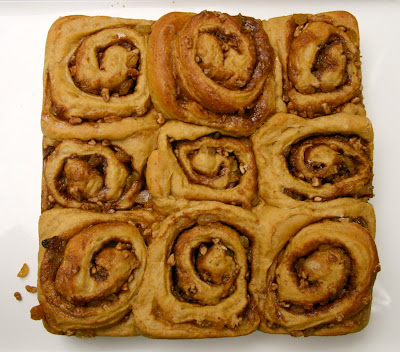Let's talk "cornbread," shall we? The
Slow & Steady subgroup of the
BBA Challenge baked Peter Reinhart's
Bacon Cornbread recipe a few weeks ago and, as is always the case when cornbread is on the menu, ingrained taste differences surfaced. The general pattern of cornbread preparation/preference is that Northerners like sweetened cornbread and Southerners, who add sugar to everything, including vegetables, mysteriously withhold all sweeteners from their cornbread (which is also most commonly baked in a cast iron skillet). We have a mix of Northern and Southern bakers in our subgroup, and one member from another continent who is blessedly immune from the great regional divide in cornbread sweetening.
Peter Reinhart includes the recipe for this cornbread - the only non-yeast bread in his book
The Bread Baker's Apprentice - because in his view the recipe was just too perfect to leave it out. With three different kinds of sweeteners in the dough, it's safe to say that Reinhart's bread reflects Northern cornbread sensibilities. Let's see how the Slow & Steady bakers reacted to this segment of the BBA Challenge!
^^^^^^^^^^^^^^^^^^^^^^^^^^^^^^^^^^^^^^^^^^^^^^^^^^^^

Margaret of
Tea and Scones enjoyed this sweet cornbread (hers is pictured at the top of the post) even though she lives in the South. She's 1/2 Southern, though, and I guess it's the other 1/2 (which she variously describes as "Yankee" and "rebel") that's responsible for her taste in cornbread! Margaret baked her bread in an iron skillet, as she does with all of her cornbread, and it turned out picture-perfect. Here's her post:
Slow and Steady BBA - Corn Bread!^^^^^^^^^^^^^^^^^^^^^^^^^^^^^^^^^^^^^^^^^^^^^^^

Not one to stray from her Southern no-sweetener-in-cornbread roots, Sarah of
Blue Ridge Baker made some modifications to the recipe and produced Brown Butter and Sage Corn Muffins. They sound and look delicious, even if they are not going to dethrone Sarah's usual recipe. Read all the details in her post:
BBA Challenge: Cornbread^^^^^^^^^^^^^^^^^^^^^^^^^^^^^^^^^^^^^^^^^^^^^^^^^^^^^^^

Jessica of
The Singleton in the Kitchen had been interested in trying this cornbread recipe on previous occasions, but was always thwarted by the recipe's overnight delay while the cornmeal soaks in buttermilk. Luckily, once she finally baked it, this cornbread lived up to the Singleton's very high expectations, providing just the right amount of sweetness. She deemed it "just about perfect" and I have no doubt she'll bake it again under just the right "plan ahead" conditions. Her post:
BBA S&S: Cornbread^^^^^^^^^^^^^^^^^^^^^^^^^^^^^^^^^^^^^^^^^^^^^^^^^^^

Di of
Di's Kitchen Notebook had an experience with this cornbread that was an all-around loss. Her muffins cratered, her 8" round bread stuck to the pan, it wasn't sweet enough for her, and she definitively proved that she doesn't like corn in her cornbread. Other than that, Mrs. Lincoln, how was the play? Well, on to bigger and better bread, is what I say! Di chronicled her tribulation with the cornbread in this post:
Sometimes You Feel Like Corn...
^^^^^^^^^^^^^^^^^^^^^^^^^^^^^^^^^^^^^^^^^^^^^^^

Karen, of the blog
Shortbread was a bit dubious about the cornbread recipe because of the three sweeteners in it. A native Southerner, she prefers non-sweet cornbread. But after baking it, she says, "this cornbread was really
fabulous. It wasn’t overly sweet, and the bacon gave it enough saltiness to balance the flavors beautifully." Read more in her post, called
Doubting Thomas Corn Bread .
^^^^^^^^^^^^^^^^^^^^^^^^^^^^^^^^^^^^^^^^^^^^^^^

Natalia of
Gatti, Fili e Farina lives in Italy, so she doesn't have to worry about the North/South cornbread debate. Cornbread is new to her, and she got to judge it on taste alone. Luckily, she liked it a lot, and enjoyed most of it plain for breakfast. Check out her post:
BBA Slow and Steady: Cornbread^^^^^^^^^^^^^^^^^^^^^^^^^^^^^^^^^^^^^^^^^^^^^^^

Kayte of
Grandma's Kitchen Table baked this cornbread as an accompaniment to chicken corn chowder. The bacon in the bread ensured it would be a big hit with her family, but Kayte didn't care for greasing the pan with bacon fat, and would substitute a milder fat next time. Her post:
BBA Challenge: Cornbread^^^^^^^^^^^^^^^^^^^^^^^^^^^^^^^^^^^^^^^^^^^^^^^

Leslie of
Lethally Delicious baked up a double batch of this cornbread. She left the cornmeal/buttermilk mixture in the fridge for a few days to develop the flavors, and while she liked the finished product, her inborn Southern preference for unsweetened cornbread influenced her final opinion (she didn't love it!). Here's Leslie's post:
BBA - Cornbread^^^^^^^^^^^^^^^^^^^^^^^^^^^^^^^^^^^^^^^^^^^^^^^

I've lived in the North and the South, and I'll eat cornbread just about any way that it's prepared. I divided my batch of cornbread, using some of the dough to bake a small bread in an iron skillet and using the remaining dough to bake muffins. We really enjoyed this bread, finding it "moist, savory, and just a little sweet." My cornbread post performed double duty, as a BBA post and also for the LiveStrong baking event in support of cancer awareness. Here's the post:
LiveSTRONG with a Taste of... Corn: Bacon Cornbread {bba}
 Just before Thanksgiving, the Washington Post Food Section produced a story featuring classic recipes from legendary chefs, updated slightly for the modern Thanksgiving table; included were Fannie Merritt Farmer's cranberry sauce, Edna Lewis' turnip soup, Julia Childs and Jacque Pepin's deconstructed turkey. Each of the dished looked appealing, but I immediately printed the recipe for James Beard Sweet Potato Dinner Rolls, and they took place front and center on our Thanksgiving table this year.
Just before Thanksgiving, the Washington Post Food Section produced a story featuring classic recipes from legendary chefs, updated slightly for the modern Thanksgiving table; included were Fannie Merritt Farmer's cranberry sauce, Edna Lewis' turnip soup, Julia Childs and Jacque Pepin's deconstructed turkey. Each of the dished looked appealing, but I immediately printed the recipe for James Beard Sweet Potato Dinner Rolls, and they took place front and center on our Thanksgiving table this year.


















